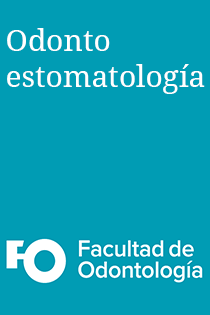Abstract
Purpose: The aim of this study was to assess clinically and radiographically the ART technique (Atraumatic Restorative Treatment) and chemical and mechanical caries removal with Papacárie, in primary molars with occlusal caries lesions, verifying presence of pain, clinical integrity of restoration and development of carious lesions. Methods. A randomized clinical trial was conducted involving 16 primary molars in patients of both sexes, aged between 3 and 6 years. These teeth were divided in two groups: G1 (n = 8) conventional ART and G2 (n = 8) Papacárie. Experiments were conducted by and the teeth were resto-red with glass ionomer cement. For the assessment of symptoms, children were asked to complete the Wong-Baker Faces Pain Rating Scale (FPS). After six months we assessed the clinical integrity of the restorations+- through the scale proposed by Frencken. Radiographic evaluation was carried out looking at the potential increase in the radiolucent area of the carious lesion. Results: Patients reported no pain during both technique execution, there was no progression of lesions and restorative material remained properly retained, in the two groups after six months. Conclusions: Both techniques showed clinical and radiographic success after six months of evaluation.
References
Frencken JE, Holmgren CJ. Tratamento Restaurador Atraumático para a cárie dentária. São Paulo: Santos, 2001. 106p.
Navarro MFL, Bresciani E, Barata TJE, Fagundes TC. Tratamento Restaurador Atraumático (ART) e o Programa de Saúde da Família. Rev Biodonto. 2004 2(4):95-96.
Porto CLA, Bandeira MFCL, Pozzbon RT. Carisolv: nova alternativa de tratamento da dentina cariada – relato de caso clínico. J Bras Clin Estet Odontol. 2001 5(25):70-73.
Schutzbank SG, Marchwinsk IM, Kronmann JH, Goldmann M, Clark RE. In vitro study of the effect of GK 101 on the removal of carious material. J. Dent Res 1975; 54:907.
Bussadori SK, Guedes CC, Fernandes KPS, Martins MD, Masuda, MS. Utilização do gel à base de papaína para remoção química e mecânica do tecido cariado. Rev Assoc Paul Cir Dent. 2006; 60(6); 450-3.
Bussadori SK, Guedes CC. Técnicas e materiais empregados para a promoção e devolução de saúde bucal. In: Saba-Chujfi E, Cicareli AJ, Zanin F. Odontologia: Resultados e Integração. São Paulo: Artes Médicas, 2008. p. 31-46.
Silva LR, Motta LJ, Reda SH, Façanha RAA, Bussadori SK. Papacárie – um novo sistema para a remoção química e mecânica do tecido cariado – relato de caso clínico. Rev Paul Odontol. 2004; 26(6): 4-8.
Carneiro RVNS, Beatrice LCS. Avaliação do grau de conhecimento dos cirurgiões-dentistas do Grande Recife sobre o sistema Carisolv. Int J Dent. 2004; 3(1):303-307.
Habib CM, Kronmam J, Goldman M. A chemical evaluation off collagen and hydroxiproline after treatment with GK 101. Pharm Ther Dent. 1975; 2:209-215.
Abdelnur JP, Cerqueira DF, Castro GF, Maia LC, de Souza IP. Strategies for addressing Restorative challenges in HIV Infected Children. J Dent Child 2008; 75(1): 69-73.
Craig KD. The facial display of pain. In: Measurement of Pain in Infants and Children. Seattle: IASP Press, 1998. p. 62-79
Frencken JE, Makoni E, Sithole WD. Atraumatic restorative treatment and glass ionomer cement sealants in school oral health programme in Zimbawe. Evaluation after 1 year. Caries Res. 1996; 30(6): 428-36.
Motta LJ, Martins MD, Fernandes KPS, Bussadori SK. Aesthetic restoration of decíduos anterior teeth after removal of caries tissue whith Papacarie. Indian J Dent Res. [serial on the Internet]. 2009 Dec [cited 2011 Oct 12]; 20(1): 117-20. Available from: http://www.ijdr. in/article.asp?issn=0970-9290;year=2009;volu me=20;issue=1;spage=117;epage=120;aulast=M otta.
Maltz M, Oliveira EF, Fontanella V, Bianchi R; A clinical microbiologic and radiografic study of deep caries lesion after in-complete caries removal. Quintessence Int. 2002;33(2):151-59.
Banerjee A, Kidd EA, Watson TF. In vitro validation of carious dentin removed using different excavation criteria. Am J Dent. 2003; 16(4):228-30.
Bussadori SK, Castro LC, Galvão N. Papain Gel: new chemo-mechanical caries removal agent. J Clin Pediatric Dent. 2005; 30:115-19.
Carrilo CM, Tanaka MH, Cesar MF, Camargo MA, Juliano Y, Novo NF. Use a papain gel in disabled patients. J Dent Child . 2008;75(3):222-228.
Banerjee A, Watson T, Kidd E. Dentine excavation: a review of current clinical techniques. Br Dent J 2000; 188:476-482.
Nadanovsky P et al. Removal of caries using only hand instruments: a comparison of mechanical and chemo-mechanical methods. Caries Res 2001; 35(5):384-389.
Weerheijm K. Groen H The residual caries dilemma Community Dent Oral Epidemiol 1999; 27:436-441.
Piva Evandro, Ogliari Fabrício Aulo, Mora-es Rafael Ratto de, Corá Felipe, Henn Sandrina, Correr-Sobrinho Lourenço. Papainbased gel for biochemical caries removal: influence on microtensile bond strength to dentin. Braz Oral Res. [serial on the Internet]. 2008 Dec [cited 2011 Oct 12] ; 22(4): 364-370. Available from: http://www.scielo.br/pdf/bor/v22n4/v22n4a14.pdf
Nicholson JW, Czarnecka B. Th e biocompatibility of resin modified glass ionômero cements for dentistry. Dent Mater. 2008; 24(12): 1702-8.
Ribeiro DA, Marques ME, Salvadori DM. Biocompatibility of glass ionomer cements using mouse lymphoma cells in vitro. J Oral Reahabil. 2006; 33(12):912-17.
Pereira AS, Silva LR, Motta LJ, Bussadori SK. Remoção químico-mecânica de cárie por meio do gel Papacárie. RGO. 2004; 52(5): 385-388.

